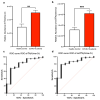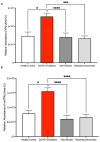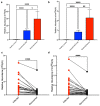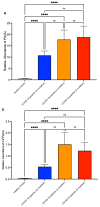t6A and ms2t6A Modified Nucleosides in Serum and Urine as Strong Candidate Biomarkers of COVID-19 Infection and Severity
- PMID: 36139072
- PMCID: PMC9496545
- DOI: 10.3390/biom12091233
t6A and ms2t6A Modified Nucleosides in Serum and Urine as Strong Candidate Biomarkers of COVID-19 Infection and Severity
Abstract
SARS-CoV-2 infection alters cellular RNA content. Cellular RNAs are chemically modified and eventually degraded, depositing modified nucleosides into extracellular fluids such as serum and urine. Here we searched for COVID-19-specific changes in modified nucleoside levels contained in serum and urine of 308 COVID-19 patients using liquid chromatography-mass spectrometry (LC-MS). We found that two modified nucleosides, N6-threonylcarbamoyladenosine (t6A) and 2-methylthio-N6-threonylcarbamoyladenosine (ms2t6A), were elevated in serum and urine of COVID-19 patients. Moreover, these levels were associated with symptom severity and decreased upon recovery from COVID-19. In addition, the elevation of similarly modified nucleosides was observed regardless of COVID-19 variants. These findings illuminate specific modified RNA nucleosides in the extracellular fluids as biomarkers for COVID-19 infection and severity.
Keywords: COVID-19; LC-MS; modified nucleosides.
Conflict of interest statement
K.T. was funded by Shimadzu Corporation and AiSTI Science Corporation. Other authors have no competing interest.
Figures






Similar articles
-
Bacteria-specific modified nucleoside is released and elevated in urine of patients with bacterial infections.mBio. 2025 Jan 8;16(1):e0312424. doi: 10.1128/mbio.03124-24. Epub 2024 Dec 11. mBio. 2025. PMID: 39660929 Free PMC article.
-
Targeted metabolomics: Liquid chromatography coupled to mass spectrometry method development and validation for the identification and quantitation of modified nucleosides as putative cancer biomarkers.Talanta. 2020 Apr 1;210:120640. doi: 10.1016/j.talanta.2019.120640. Epub 2019 Dec 16. Talanta. 2020. PMID: 31987192
-
Identification of urinary modified nucleosides and ribosylated metabolites in humans via combined ESI-FTICR MS and ESI-IT MS analysis.J Am Soc Mass Spectrom. 2008 Oct;19(10):1500-13. doi: 10.1016/j.jasms.2008.06.015. Epub 2008 Jun 28. J Am Soc Mass Spectrom. 2008. PMID: 18657436
-
LC-MS/MS: A sensitive and selective analytical technique to detect COVID-19 protein biomarkers in the early disease stage.Expert Rev Proteomics. 2023 Jan-Mar;20(1-3):5-18. doi: 10.1080/14789450.2023.2191845. Epub 2023 Mar 17. Expert Rev Proteomics. 2023. PMID: 36919634 Review.
-
Nucleoside Inhibitors of Coronaviruses.Curr Med Chem. 2021;28(26):5284-5310. doi: 10.2174/0929867328666210208181724. Curr Med Chem. 2021. PMID: 33563148 Review.
Cited by
-
m6A Methylation in Regulation of Antiviral Innate Immunity.Viruses. 2024 Apr 13;16(4):601. doi: 10.3390/v16040601. Viruses. 2024. PMID: 38675942 Free PMC article. Review.
-
Human DUS1L catalyzes dihydrouridine modification at tRNA positions 16/17, and DUS1L overexpression perturbs translation.Commun Biol. 2024 Oct 2;7(1):1238. doi: 10.1038/s42003-024-06942-8. Commun Biol. 2024. PMID: 39354220 Free PMC article.
-
Untargeted Metabolomics and Targeted Phytohormone Profiling of Sweet Aloes (Euphorbia neriifolia) from Guyana: An Assessment of Asthma Therapy Potential in Leaf Extracts and Latex.Metabolites. 2025 Mar 5;15(3):177. doi: 10.3390/metabo15030177. Metabolites. 2025. PMID: 40137143 Free PMC article.
-
Multi-omic signatures of host response associated with presence, type, and outcome of enterococcal bacteremia.mSystems. 2025 Feb 18;10(2):e0147124. doi: 10.1128/msystems.01471-24. Epub 2025 Jan 21. mSystems. 2025. PMID: 39835799 Free PMC article.
-
NSUN3-mediated mitochondrial tRNA 5-formylcytidine modification is essential for embryonic development and respiratory complexes in mice.Commun Biol. 2023 Mar 22;6(1):307. doi: 10.1038/s42003-023-04680-x. Commun Biol. 2023. PMID: 36949224 Free PMC article.
References
-
- Sugiyama M., Kinoshita N., Ide S., Nomoto H., Nakamoto T., Saito S., Ishikane M., Kutsuna S., Hayakawa K., Hashimoto M., et al. Serum CCL17 level becomes a predictive marker to distinguish between mild/moderate and severe/critical disease in patients with COVID-19. Gene. 2021;766:145145. doi: 10.1016/j.gene.2020.145145. - DOI - PMC - PubMed
-
- Ruan Y., Hu B., Liu Z., Liu K., Jiang H., Li H., Li R., Luan Y., Liu X., Yu G., et al. No detection of SARS-CoV-2 from urine, expressed prostatic secretions, and semen in 74 recovered COVID-19 male patients: A perspective and urogenital evaluation. Andrology. 2021;9:99–106. doi: 10.1111/andr.12939. - DOI - PubMed
Publication types
MeSH terms
Substances
Supplementary concepts
LinkOut - more resources
Full Text Sources
Medical
Miscellaneous

